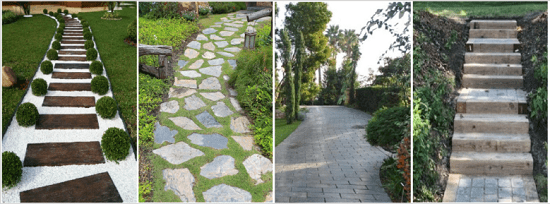Landforms in Landscaping, When it comes to landscape design, especially when it comes to rugged terrains, terrain conditions are the most prominent factor in landscape design. They are the main factor that directs landscape design. The landscape designer can create different arrangements by changing the existing land within certain limits. But this intervention must be to a certain extent. Arrangements should be made without disturbing the natural structure of the land. Actions to be taken differently from this may cause the destruction of the natural structure and appearance of the land. Natural or regulated land forms are suitable for many different purposes.
Landforms in Landscaping, Climatic characteristics of the site and its immediate surroundings (temperature, humidity, wind etc.), natural environmental features such as soil structure, geological structure, hydrological structure and its relationship with surrounding structures and settlements, socio-cultural structure cultural characteristics are investigated.

Obtain basic information about environmental characteristics before going to the field in the field, some notes are taken that will shed light on the design, quick sketches studies are carried out, and if necessary, a survey of the area is made.
Preparation of structural landscape application project Structural elements, i.e. walls, vehicular and pedestrian roads and connections, water surfaces, plastic and artistic elements, urban furniture, lighting, etc. naming, coding, listing and dimensioning is made. In the same scale with the final project is studied.
Determination of the names and locations of all structural elements – Surface drainage systems, – Irrigation systems, – Infrastructure systems, – Neighborhood lists, – Detail reference numbers Such elements are also included in structural application projects.
Selecting Plants for Landscaping in America
Preparation of vegetative landscape application project Considering the average size and crown widths that the plants may reach in the future
Plants in vegetative landscape application projects prepared by taking;
- Coniferous trees and shrubs
- Leafy trees and shrubs
- Evergreen and deciduous shrubs
- Perennial plants (perennials)
- Seasonal plants
- In-water and riparian plants
- Climbing plants
- Ground cover plants. It is categorized under the headings and indicated with their names, locations and numbers, are expressed in appropriate symbols.
Latin names of plants in plant landscape application projects and numbers are abbreviated. Plant names, the first two letters of the genus name and the first three letters of the species names, if any are abbreviated to the first letter of the variety.
What is involved in Landscaping in the United States?
Landscaping in the United States involves a range of practices aimed at designing, planning, and maintaining outdoor spaces to enhance their aesthetic appeal, functionality, and environmental sustainability. Here are key aspects involved in landscaping:

- Site Analysis:
- Before beginning a landscaping project, professionals conduct a site analysis. This involves assessing the existing conditions of the site, including soil type, topography, climate, existing vegetation, and any architectural features.
- Design and Planning:
- Landscape designers create plans that outline the desired layout of outdoor spaces. This includes the placement of plants, trees, shrubs, hardscape elements (such as patios and pathways), water features, and other design elements.
- Plant Selection:
- Choosing appropriate plants is a critical aspect of landscaping. Factors like climate, soil conditions, and the desired aesthetic are considered when selecting trees, shrubs, flowers, and other vegetation.
- Hardscaping:
- Hardscaping involves the installation of non-living elements in the landscape, such as pathways, patios, retaining walls, decks, and outdoor structures. These elements add structure and functionality to the outdoor space.
- Lawn Installation:
- The installation and maintenance of lawns, including the selection of grass varieties, seeding or sodding, and ongoing lawn care practices.
- Irrigation Systems:
- Designing and installing irrigation systems to ensure proper water distribution to plants. This may include drip irrigation, sprinkler systems, or other efficient watering methods.
- Outdoor Lighting:
- Integrating lighting elements to enhance the visual appeal and usability of outdoor spaces during the evening. This can include path lighting, accent lighting, and other fixtures.
- Maintenance Services:
- Ongoing maintenance is crucial for preserving the beauty of landscaped areas. This includes tasks such as mowing, pruning, fertilizing, pest control, and general upkeep of plants and hardscape features.
- Sustainability Practices:
- Increasingly, landscaping practices in the U.S. are incorporating sustainable and eco-friendly approaches. This may involve using native plants, implementing water-efficient irrigation, and adopting organic gardening practices.
- Project Management:
- Landscape projects often require project management to ensure that the design is executed according to plan. This involves coordinating various elements, managing resources, and overseeing construction activities.
- Landscape Architecture:
- In more extensive projects or in the design of public spaces, landscape architects may be involved. Landscape architects have a professional degree and are licensed to practice, often working on larger projects that involve planning and design.
- Regulatory Compliance:
- Compliance with local regulations, zoning codes, and environmental restrictions is an essential aspect of landscaping projects. Professionals need to be aware of and adhere to relevant regulations.
Landscaping practices can vary based on geographic location, climate, and the specific goals of the property owner or client. Professionals in the field may include landscape architects, designers, contractors, and maintenance crews.
